Feast your eyes on the world's most outstanding architectural photographs, videos, visualizations, drawing and models: Introducing the winners of Architizer's inaugural Vision Awards. Sign up to receive future program updates >
Every good architectural drawing has a story. From simple linework to complex colors, vectors and forms, a drawing is a visual record of how we think. At its best, a single work can encapsulate the ideology of a designer. Drawing is intrinsically tied to the art of communicating what we see or what could be, making conceptual ideas tangible and understandable.
How does a drawing tell a story? Central to Architizer’s global ideas competition, the One Drawing Challenge asks designers to see how far they can illustrate their ideas through a single work. This year, we are excited to be able to offer our largest prize fund to date for our One X Challenge competition series: A total of $6,000 will be split evenly between 2 Top Winners (1 student and 1 non-student).
As well as their cash prize, our Top Winners will have top billing in the Official Winners Announcement (see last year’s announcement here), as well as an exclusive interview about their work. A further 100 Finalists will also see their work published globally in one of our most viewed editorial features of the year: 100 Stories That Tell Powerful Stories About Architecture.
Both Top Winners will also secure themselves a seat on next season’s competition jury, giving them the opportunity to review entries alongside the likes of James Wines on SITE, Amanda Ferber of Architecture Hunter, Bob Borson of Life of an Architect and more!
Enter the 2022 One Drawing Challenge
To inspire your entry, explore the following five drawings, each of which tell their story in different ways. Looking closer, examine how the work communicates the architect’s intent through details, graphic styles and composition. They show a range of work: how drawings are tied to built forms, how a story is told through vectors, or how a drawing can be architecture in its own right.
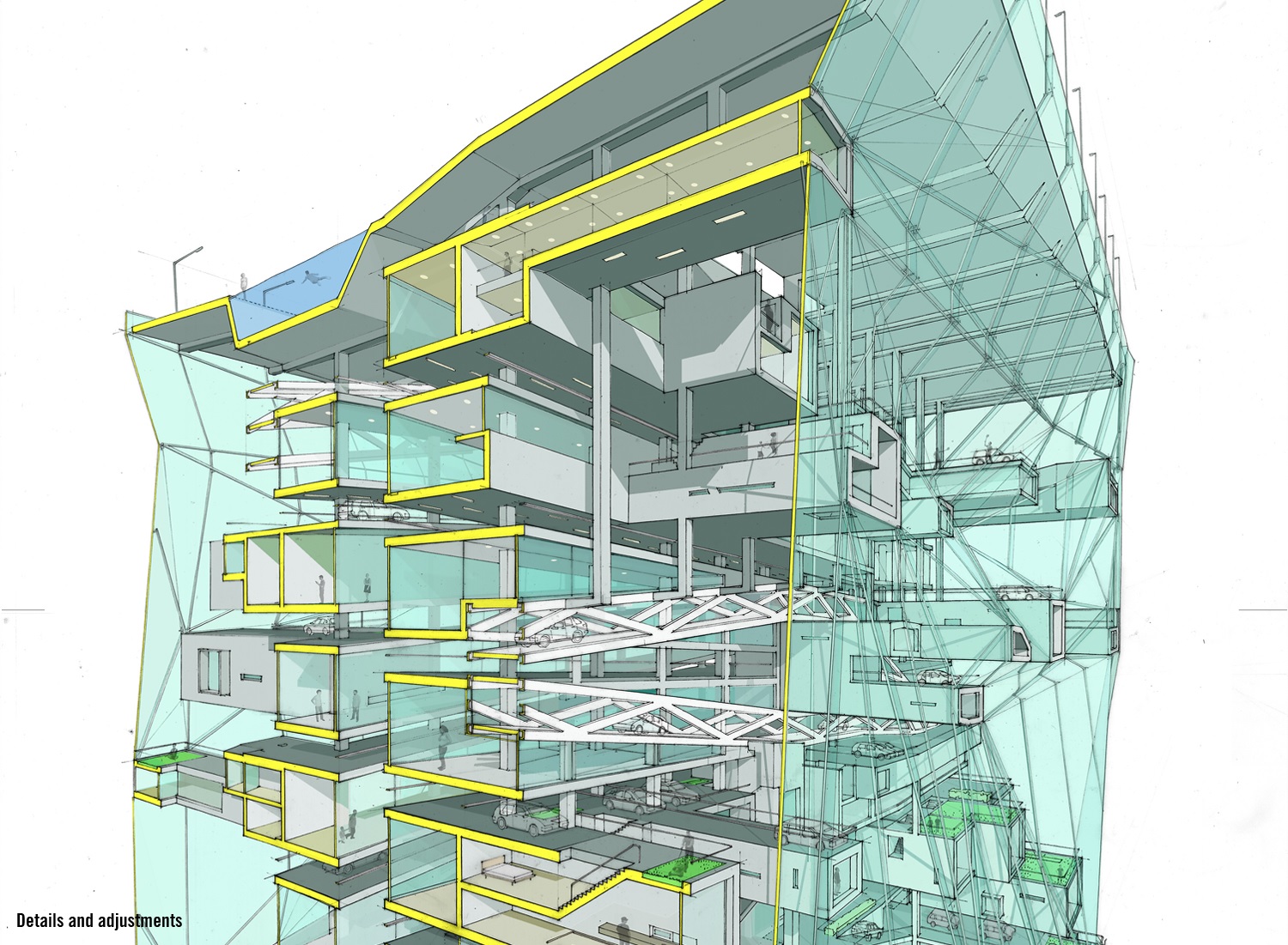
Overdrawing, Courtesy LTL Architects
A practice known for bringing out the best qualities of representation and translation, LTL Architects has developed their own drawing technique to illustrate their ideas. Dubbed Overdrawing, the technique aims to resolve the split between proponents of traditional forms of architectural representation (drawing by hand, sketching, and hardline constructions) and generative immersive representations. As they state, it’s an agile exchange between line and color, between drawing and production, between manual and digital means of working in order to circumvent current frames of thinking.
In this example, you can see how the drawing combines what works best from the overlaps of disparate mediums and methods. Through an exchange between scanners, printers, software and parallel rules, the team made a rendering that was overdrawn by hand, with detailed development and design alterations to the initial form emerging in the process. The drawing is then scanned and reunited with the original rendering, and this hybrid image is further digitally manipulated to capitalize on the qualities of both media.
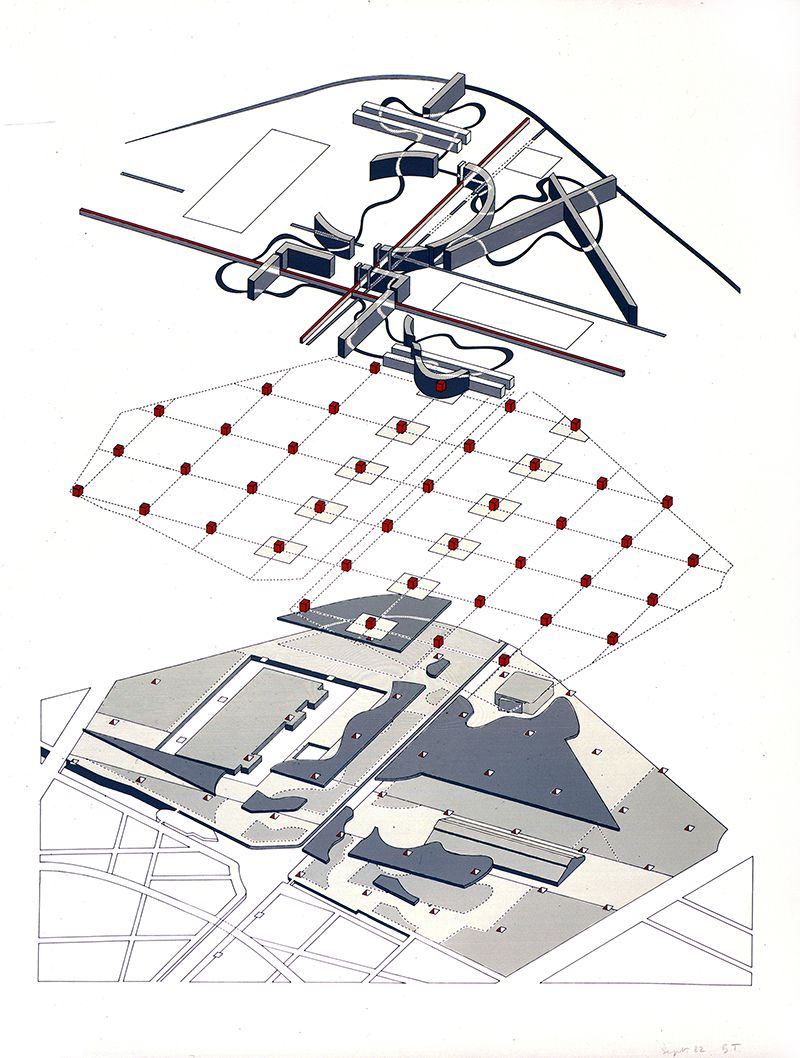
Exploded Axon, Parc de la Villette, Courtesy Bernard Tschumi Architects
Exploded Axon, Parc de la Villette by Bernard Tschumi
Bernard Tschumi’s work is about viewing buildings as a series of arguments, ideas, influences and responses to the contemporary definition of architecture today. Tschumi’s major architectural projects are usually organized around two primary ideas: concept and notation. As the work aspires to illustrate, there is no architecture without an idea or concept, just as there is no architecture without a method of notation to express its content.
In this exploded axon of Parc de la Villette, Tschumi reveals his concept for a system of dispersed “points” — red enameled steel follies that support different cultural and leisure activities. The drawing directly expresses how these are superimposed on a system of lines that emphasizes movement through the park. La Villette has become known as an unprecedented type of park, one based on culture rather than nature. In addition to the master plan, the project involved the design and construction of over 25 buildings, promenades, covered walkways, bridges, and landscaped gardens over a period of fifteen years.
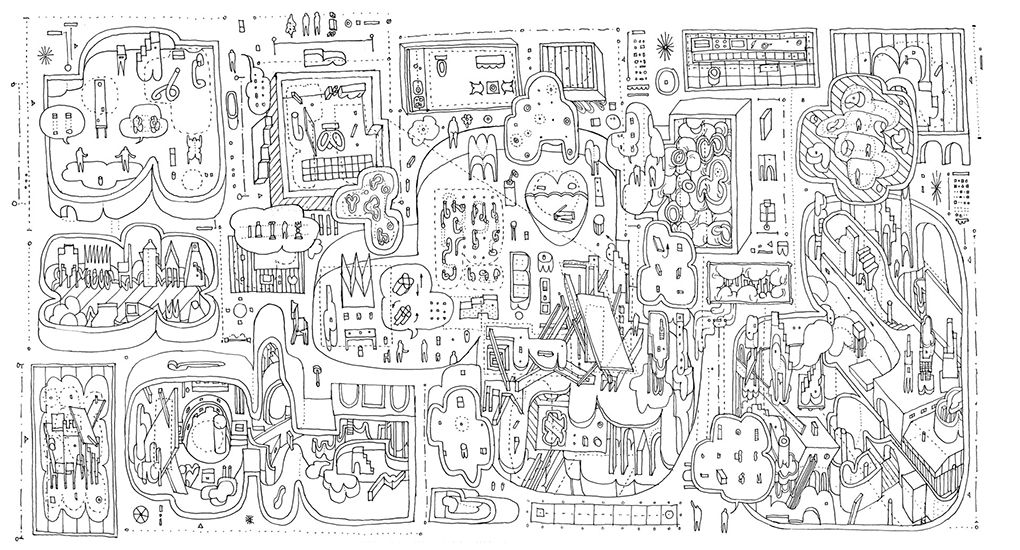
Insideoutsidebetweenbeyond, Courtesy SFMOMA, Bureau Spectacular
Insideoutsidebetweenbeyond by Bureau Spectacular
Bureau Spectacular imagines other worlds and engages the design of architecture through telling stories: Beautiful stories about character development, relationships, curiosities and attitudes, and absurd stories about fake realities that invite enticing possibilities. The stories conflate design, representation, theory, criticism, history and taste into cartoon pages. These cartoon narratives swerve into the physical world through architectural installations, models and small buildings.
These ideas are explored as seen in the drawing insideoutsidebetweenbeyond. The Los Angeles-based studio views architecture as a medium capable of rewriting cultural narratives. Questioning the banality of the existing typical urban environment, Bureau Spectacular suggests that economic efficiency is driving a character-less architecture — and that, as monuments to civilization, modern cities’ ubiquitous skyscrapers reflect a predictable, mono-cultural society. The drawing reconsiders urban architecture inside, outside, between, and beyond the monotonous rectangular buildings seen in most city skylines.
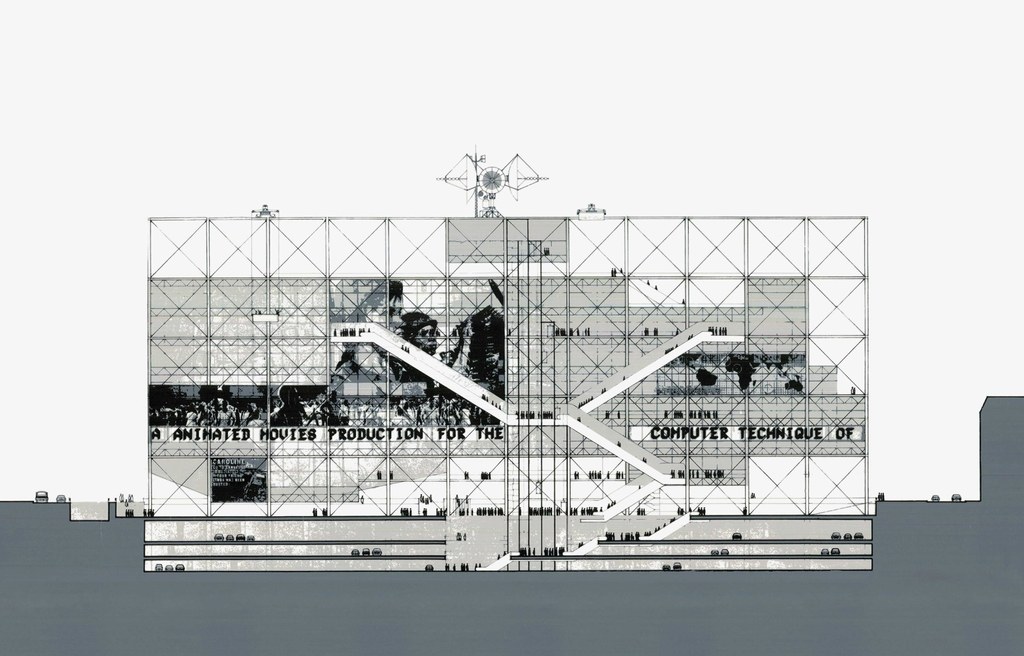
Pompidou Centre by Renzo Piano and Richard Rogers
Pompidou Centre by Renzo Piano and Richard Rogers
Renzo Piano and Richard Rogers used pencil to draw this 1971 image of the Pompidou Centre. At the center of the cross-sectional drawing is an interactive and layered façade, as illustrated in the work itself. The international competition in 1970 was to design a new, multidisciplinary cultural centre in Paris. Strategically sited between the redeveloped Les Halles markets and the historic Marais district, Piano and Rogers’ rectangular volume was proposed to take up only half the city block of the competition site.
Named after the then-President of France, Georges Pompidou, the project was first conceptualized in 1969 in the wake of the anti-capitalist May 1968 riots. The building itself was immediately embraced as a sensational popular monument, and the drawing begins to tell the story of how Renzo and Rogers conceptualized the building as a new way to exhibit and place for people to gather. By rethinking mechanical systems and standards of circulation, the project told a powerful story and became an icon for the city.
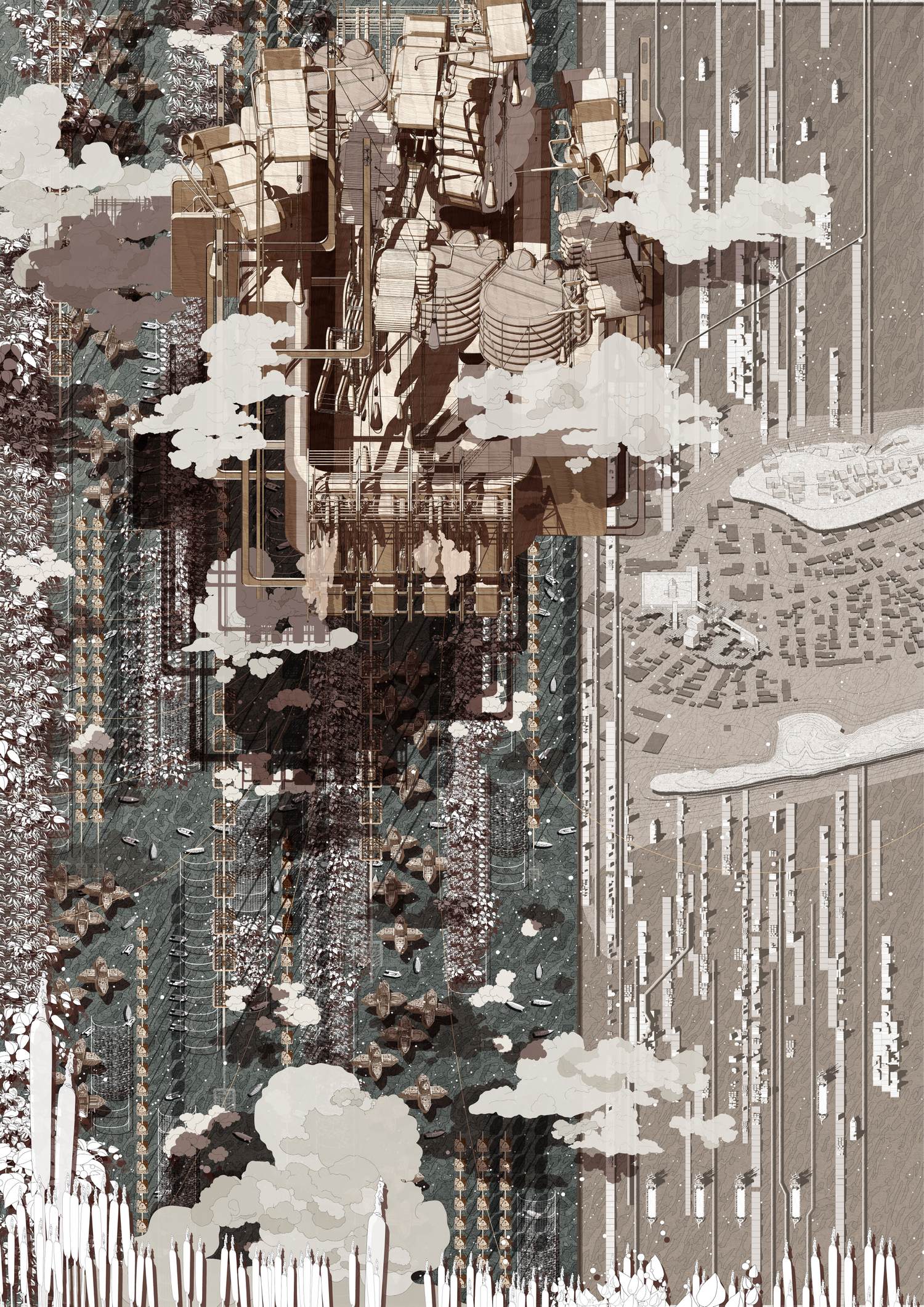
The Ministry of Ocean Wisdom by Victor Moldoveanu
The Ministry of Ocean Wisdom by Victor Moldoveanu
Inspired by Jules Verne’s In Search of the Castaways, where heroes travel the oceans of the world to find and save the lost crew, The Ministry of Ocean Wisdom is a conceptual project that was designed to occupy 20,000 square kilometers of the Danish Territorial Waters of the Jutland Peninsula. Taking into account the foreseeable sea-level increase across Denmark, The Ministry of Ocean Wisdom is a project showing a model of embracing ocean level rise and consequently taking up life on water.
In Victor’s project The Ministry has a strategic approach to the foreseeable event of ocean level rise and it operates through a set of components that prepare, protect and provide for the population and the territory under flood threat. These components include habitation, transportation, natural environment, infrastructure, and logistics. As the first in a set of drawings, this particular work utilizes an overlay of pattern, scale and detail to tell a complex story of the ministry and the pieces that make up the project.
Now show us what you can do: Take on the One Drawing Challenge and submit your best architectural drawing for a chance to win $3,000!
Enter the 2022 One Drawing Challenge
Top image: Sapphire City by Michael Quach, Bartlett School of Architecture






 CENTRE POMPIDOU
CENTRE POMPIDOU 


